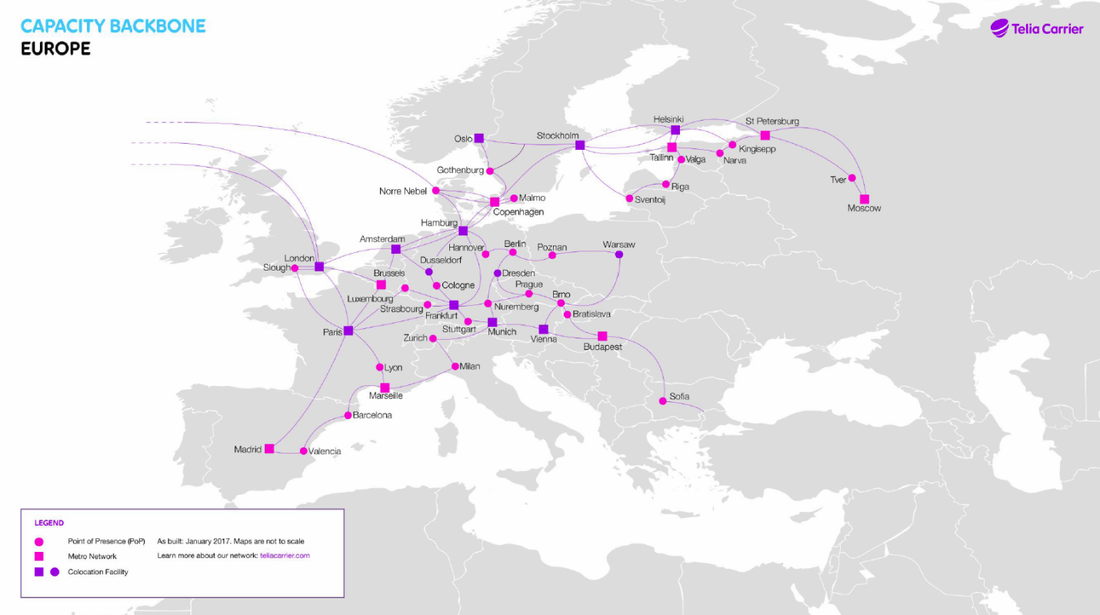|
Telia Carrier today announced that it has established a new route stretching from Stockholm, Sweden to St. Petersburg, Russia via Tallinn, Estonia, and has upgraded multiple submarine cables to future proof its network, bringing lower latency and additional capacity. The new route further diversifies the wholesale carrier’s network and the upgrade enables Telia Carrier to provide 100G+ services to carriers, content and cloud providers in the Baltics, Russia and beyond. Figure 8 - Telia European Network Source: Telia
The new network extension is the most direct route possible from Stockholm to St. Petersburg at just under 900 km. With a connection in Tallinn, Estonia, Telia Carrier’s mesh network extends in different directions reaching multiple cities including Riga, Latvia, or Helsinki, Finland. This added diversity and geographical reach extends the value of the top-two ranked global backbone, AS1299. As St. Petersburg and Moscow are important transit points for Asian traffic, the new route also allows Telia Carrier to service the increase in traffic coming into Europe from Asia via terrestrial cable routes from the East as well as directly from Russia. The subsea cables reaching across the Baltic Sea have been upgraded using the latest coherent Flex-Grid technology allowing Telia Carrier to offer 100G, and future 150G and 200G services leveraging the latest modulation formats. “As our network becomes more meshed throughout Eastern Europe and the Baltics, we are continuing to build out eastward to stay ahead of content demand and the resulting backbone traffic in the region,” said Johan Godal, global product manager, wavelength and network outsourcing services at Telia Carrier. “By extending the route from Sweden to Russia and upgrading the submarine cables in the Baltic Sea, we can now offer high capacity and low latency services via a highly-meshed network throughout the region.” Telia Carrier’s global fiber backbone has grown organically, without acquisitions, and is the first to be 100G-enabled in both Europe and North America. It is also the first network to successfully transmit 1 Tbit/s on its US network. According to Dyn Research’s global backbone rankings, AS1299, Telia Carrier’s global IP backbone is currently ranked top-two. Telia Carrier’s rapid growth and ascension through the rankings was recently highlighted in Dyn’s ‘Baker’s Dozen, 2015 edition’ report. The company enables worldwide connectivity by connecting more than 220 Points of Presence (PoPs) across Europe, North America, Asia, and the Middle East including over 70 PoPs in North America alone. Source: Telia Press Release ANALYSIS: Infinera is probably the most careful of all the upgrade vendors in keeping its customers and contracts as anonymous as possible. However, Telia's reference to "Flex-Grid" is likely to be Infinera's "FlexCoherent" platform which offers the ability to upgrade through 100G, 200G, to 500G. Telia's strategy to focus on IP Transit connectivity and coverage has enabled the company to come from nowhere and become one of the leading upstream IP providers in the World. This is a strategy that will protect the carrier more so than others from the onslaught by the content providers who are intent on making carriers obsolete. Telia stresses in its press release that the growth of its network is completely organic. This means that they are leasing network from 3rd parties instead of building new fiber. This is probably a sensible strategy in the short term as prices for international capacity continue to head south, spurred by technological advancements. However, this contrasts strongly with the strategy of Google, Microsoft, and Facebook (though not as yet, Amazon) which is to own their own physical infrastructure. The decision to invest in upgrading relatively old submarine fiber optic cables in the Baltic is also interesting. Coming on the heels of the rise of Cinia in Finland who have built a new Baltic cable to Germany and are also developing their network in North Western Europe, there may be a trend developing which sees the Baltic area becoming a more important "back door" for Russian and Asian access to Western Europe.
0 Comments
Leave a Reply. |
Julian Rawle, AuthorThought leadership articles and commentary on developments related to the subsea fibre optic cable industry can be found here. Archives
February 2018
Categories |




 RSS Feed
RSS Feed